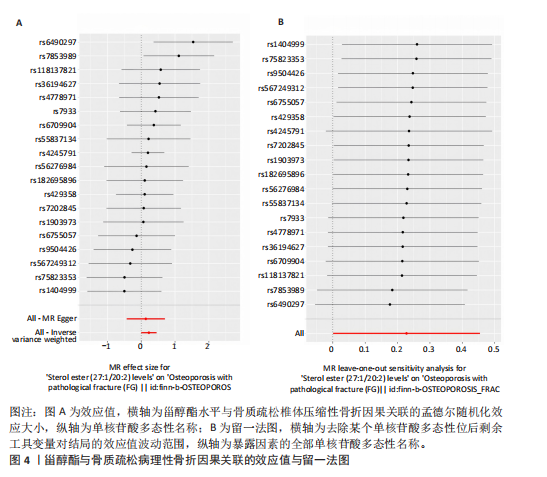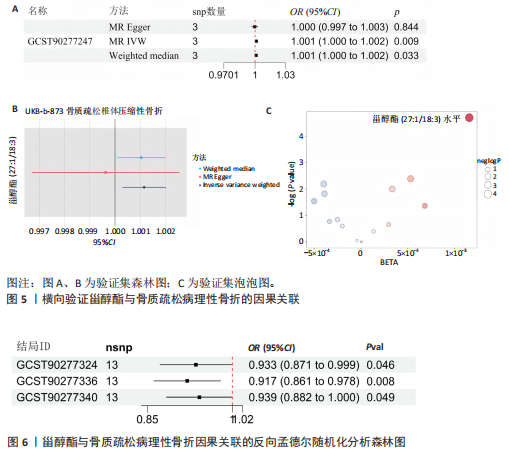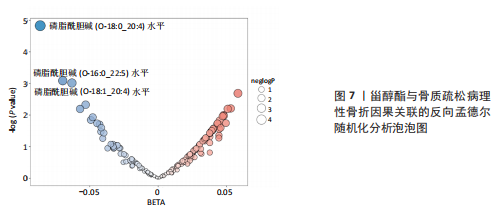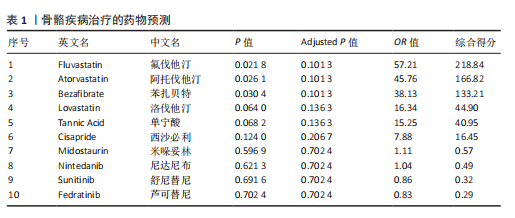[1] SING C, LIN T, BARTHOLOMEW S, et al. Global Epidemiology of Hip Fractures: Secular Trends in Incidence Rate, Post‐Fracture Treatment, and All‐Cause Mortality. J Bone Miner Res. 2023;38(8):1064-1075.
[2] GOLD LS, SURI P, O’REILLY MK, et al. Mortality among older adults with osteoporotic vertebral fracture. Osteoporos Int. 2023;34(9):1561-1575.
[3] SHAO L, LUO S, ZHAO Z. Lipid metabolites are associated with the risk of osteoporotic fractures. Sci Rep. 2024;14(1):19245.
[4] WU M, DU Y, ZHANG C, et al. Mendelian Randomization Study of Lipid Metabolites Reveals Causal Associations with Heel Bone Mineral Density. Nutrients. 2023;15(19): 4160.
[5] SFEIR JG, DRAKE MT, KHOSLA S, et al. Skeletal Aging. Mayo Clin Proc. 2022;97(6): 1194-1208.
[6] GUO D, ZHAO M, XU W, et al. Dietary interventions for better management of osteoporosis: An overview. Crit Rev Food Sci Nutr. 2021;63(1):125-144.
[7] CHE Y, YANG J, TANG F, et al. New Function of Cholesterol Oxidation Products Involved in Osteoporosis Pathogenesis. Int J Mol Sci. 2022;23(4):2020.
[8] HUANG CY, CHENG M, WANG PH. The negative correlation between osteoporosis and hyperlipidemia: Is it real? Taiwan J Obstet Gynecol. 2020;59(3):471-472.
[9] LARSSON SC, BUTTERWORTH AS, BURGESS S. Mendelian randomization for cardiovascular diseases: principles and applications. Eur Heart J. 2023;44(47): 4913-4924.
[10] RICHMOND RC, SMITH GD. Mendelian Randomization: Concepts and Scope. Cold Spring Harb Perspect Med. 2021;12(1): a040501.
[11] HUANG J, GUI Y, WU J, et al. Causal effects of socioeconomic traits on frailty: a Mendelian randomization study. Front Med (Lausanne). 2024;11:1344217.
[12] PENG B, MENG H, GUO L, et al. Anxiety disorder and cardiovascular disease: a two‐sample Mendelian randomization study. ESC Heart Fail. 2024;11(2):1174-1181.
[13] STRAUSZ T, STRAUSZ S, JONES SE, et al. A Two-Sample Mendelian Randomization Study of Neuroticism and Sleep Bruxism. J Dent Res. 2024;103(10):980-987.
[14] ZHANG Y, ZHONG Z, TANG Z, et al. Insomnia and sleep duration for kidney function: Mendelian randomization study. Ren Fail. 2024;46(2):2387430.
[15] GKATZIONIS A, BURGESS S, NEWCOMBE PJ. Statistical methods for cis‐Mendelian randomization with two‐sample summary‐level data. Genet Epidemiol. 2023;47(1): 3-25.
[16] HU X, ZHAO J, LIN Z, et al. Mendelian randomization for causal inference accounting for pleiotropy and sample structure using genome-wide summary statistics. Proc Natl Acad Sci U S A. 2022; 119(28):e2106858119.
[17] BURGESS S, SMITH GD, DAVIES NM, et al. Guidelines for performing Mendelian randomization investigations: update for summer 2023. Wellcome Open Res. 2023;4:186.
[18] BOWDEN J, SMITH GD, HAYCOCK PC, et al. Consistent Estimation in Mendelian Randomization with Some Invalid Instruments Using a Weighted Median Estimator. Genet Epidemiol. 2016;40(4): 304-314.
[19] MACKAY TFC, ANHOLT RRH. Pleiotropy, epistasis and the genetic architecture of quantitative traits. Nat Rev Genet. 2024; 25(9):639-657.
[20] BURGESS S, THOMPSON SG. Interpreting findings from Mendelian randomization using the MR-Egger method. Eur J Epidemiol. 2017;32(5):377-389.
[21] CHERNY SS, FREIDIN MB, WILLIAMS FMK, et al. The analysis of causal relationships between blood lipid levels and BMD. PLoS One. 2019;14(2):e0212464.
[22] DEPTA L, WHITMARSH-EVERISS T, LARAIA L. Structure, function and small molecule modulation of intracellular sterol transport proteins. Bioorg Med Chem. 2022;68: 116856.
[23] LUO J, YANG H, SONG BL. Mechanisms and regulation of cholesterol homeostasis. Nat Rev Mol Cell Biol. 2019;21(4):225-245.
[24] KIM H, OH B, PARK-MIN KH. Regulation of Osteoclast Differentiation and Activity by Lipid Metabolism. Cells. 2021;10(1):89.
[25] 李坤.胆固醇在BMSCs成骨分化中的双重作用及机制研究[D].苏州:苏州大学, 2019.
[26] DONG B, SINGH AB, FUNG C, et al. CETP inhibitors downregulate hepatic LDL receptor and PCSK9 expression in vitro and in vivo through a SREBP2 dependent mechanism. Atherosclerosis. 2014;235(2):449-462.
[27] SAMMONS E, HOPEWELL JC, CHEN F, et al. Long-term safety and efficacy of anacetrapib in patients with atherosclerotic vascular disease. Eur Heart J. 2021;43(14): 1416-1424.
[28] LANDRAY MJ. Randomized Evaluation of the Effects of Anacetrapib through Lipid-modification (REVEAL)-A large-scale, randomized, placebo-controlled trial of the clinical effects of anacetrapib among people with established vascular disease: Trial design, recruitment, and baseline characteristics. Am Heart J. 2017;187:182-190.
[29] 饶甲环,马煜盛,龙洁旎,等.胆固醇酯转移蛋白抑制剂的研究进展[J].医学研究生学报,2019,32(7):776-779.
[30] DORIGHELLO GG, ASSIS LHP, RENTZ T, et al. Novel Role of CETP in Macrophages: Reduction of Mitochondrial Oxidants Production and Modulation of Cell Immune-Metabolic Profile. Antioxidants (Basel). 2022;11(9):1734.
[31] GONEN A, MILLER YI. From Inert Storage to Biological Activity—In Search of Identity for Oxidized Cholesteryl Esters. Front Endocrinol (Lausanne). 2020;11:602252.
[32] ARABI SM, CHAMBARI M, BAHRAMI LS, et al. The Effect of Statin Therapy on Bone Metabolism Markers and Mineral Density: Aa GRADE-Assessed Systematic Review and Dose-Response Meta-Analysis of Randomized Controlled Trials. Adv Pharm Bull. 2024;14(3):591-603.
[33] ZHENG J, BRION M, KEMP JP, et al. The Effect of Plasma Lipids and Lipid-Lowering Interventions on Bone Mineral Density: A Mendelian Randomization Study. J Bone Miner Res. 2020;35(7):1224-1235.
[34] KUWAHARA M, AKASAKI Y, GOTO N, et al. Fluvastatin promotes chondrogenic differentiation of adipose-derived mesenchymal stem cells by inducing bone morphogenetic protein 2. BMC Pharmacol Toxicol. 2022;23(1):61.
[35] CRISTANCHO AG, LAZAR MA. Forming functional fat: a growing understanding of adipocyte differentiation. Nat Rev Mol Cell Biol. 2011;12(11):722-734.
[36] MATSUSHITA Y, ONO W, ONO N. Toward Marrow Adipocytes: Adipogenic Trajectory of the Bone Marrow Stromal Cell Lineage. Front Endocrinol (Lausanne). 2022;13: 882297.
[37] LIN Z, HE H, WANG M, et al. MicroRNA-130a controls bone marrow mesenchymal stem cell differentiation towards the osteoblastic and adipogenic fate. Cell Prolif. 2019;52(6): e12688.
[38] LU CC, QIN H, ZHANG ZH, et al. The association between keloid and osteoporosis: real-world evidence. BMC Musculoskelet Disord. 2021;22(1):39.
[39] CHEN HM, HSU CY, PAN BL, et al. Association of Decreased Bone Density and Hyperlipidemia in a Taiwanese Older Adult Population. J Endocr Soc. 2024;8(5): bvae035.
[40] ABBASLOO S, AGHAEI MEYBODI HR, FAHIMFAR N, et al. The associations of statin intake and the trabecular bone score and bone mineral density status in elderly Iranian intdiduals: a cross-sectional analysis of the Bushehr Elderly Health (BEH) program. Arch Osteoporos. 2021;16(1):144.
[41] HERNÁNDEZ JL, OLMOS JM, ROMAÑA G, et al. Bone mineral density in statin users: a population-based analysis from a Spanish cohort. J Bone Miner Metab. 2013; 32(2):184-191.
[42] LI W, HUANG Z, FANG W, et al. Remnant Cholesterol Variability and Incident Ischemic Stroke in the General Population. Stroke. 2022;53(6):1934-1941.
[43] GONEL A, KIRHAN I, KOYUNCU I, et al. The Role of Interferences in the Increasing Incidence of Vitamin D Deficiency. Endocr Metab Immune Disord Drug Targets. 2020; 20(8):1303-1308.
[44] LING Y, XU F, XIA X, et al. Vitamin D supplementation reduces the risk of fall in the vitamin D deficient elderly: An updated meta-analysis. Clin Nutr. 2021;40(11):5531-5537.
[45] LI L, LIU Y, LIU X, et al. Regulatory roles of external cholesterol in human airway epithelial mitochondrial function through STARD3 signalling. Clin Transl Med. 2022; 12(6):e902.
[46] JANG MY, CHUN SI, MUN CW, et al. Evaluation of Metabolomic Changes as a Biomarker of Chondrogenic Differentiation in 3D-cultured Human Mesenchymal Stem Cells Using Proton (1H) Nuclear Magnetic Resonance Spectroscopy. PLoS One. 2013; 8(10):e78325.
[47] ZHAI G, RANDELL EW, RAHMAN P. Metabolomics of osteoarthritis: emerging novel markers and their potential clinical utility. Rheumatology. 2018;57(12):2087-2095.
[48] YANG CD, CHUANG SC, CHENG TL, et al. An Intermediate Concentration of Calcium with Antioxidant Supplement in Culture Medium Enhances Proliferation and Decreases the Aging of Bone Marrow Mesenchymal Stem Cells. Int J Mol Sci. 2021;22(4):2095.
[49] ZHAN J, LUO D, ZHAO B, et al. Polydatin administration attenuates the severe sublesional bone loss in mice with chronic spinal cord injury. Aging. 2022;14(21):8856-8875.
[50] SHORE DM, REGGIO PH. The therapeutic potential of orphan GPCRs, GPR35 and GPR55. Front Pharmacol. 2015;6:69.
[51] MILLER MR, ABSHIRINI M, WOLBER FM, et al. Greenshell Mussel Products: A Comprehensive Review of Sustainability, Traditional Use, and Efficacy. Sustainability. 2023;15(5):3912.
[52] ODOEMELAM CS, HUNTER E, EBERL D, et al. The Role of Phorbol Diesters in Mediating Human Placental Aromatase Cytochrome P450 Activity. Appl Biosci. 2022;1(3):279-288.
[53] BOZELLI JC, AZHER S, EPAND RM. Plasmalogens and Chronic Inflammatory Diseases. Front Physiol. 2021;12:730829.
[54] DURKOVICOVA Z, FAKTOROVA X, JAKABOVICOVA M, et al. Molecular mechanisms in the pathogenesis of metabolically associated fatty liver disease. Bratisl Lek Listy. 2023;124(6):427-436.
[55] WANG Z, WANG X, WANG Y, et al. NanoZnO-modified titanium implants for enhanced anti-bacterial activity, osteogenesis and corrosion resistance. J Nanobiotechnology. 2021;19(1):353.
[56] CHAMANI S, LIBERALE L, MOBASHERI L, et al. The role of statins in the differentiation and function of bone cells. Eur J Clin Invest. 2021;51(7):e13534.
[57] BAO C, WU T, ZHU S, et al. Regulation of cholesterol homeostasis in osteoporosis mechanisms and therapeutics. Clin Sci (Lond). 2023;137(15):1131-1143.
[58] LIN SM, WANG JH, LIANG CC, et al. Statin Use Is Associated With Decreased Osteoporosis and Fracture Risks in Stroke Patients. J Clin Endocrinol Metab. 2018;103(9):3439-3448.
[59] DE NEGRI ATANASIO G, FERRARI PF, CAMPARDELLI R, et al. Poly (Lactic-co-Glycolic Acid) Nanoparticles and Nanoliposomes for Protein Delivery in Targeted Therapy: A Comparative In Vitro Study. Polymers (Basel). 2020;12(11):2566.
[60] SŁOTA D, PIĘTAK K, JAMPILEK J, et al. Polymeric and Composite Carriers of Protein and Non-Protein Biomolecules for Application in Bone Tissue Engineering. Materials (Basel). 2023;16(6):2235.
|





